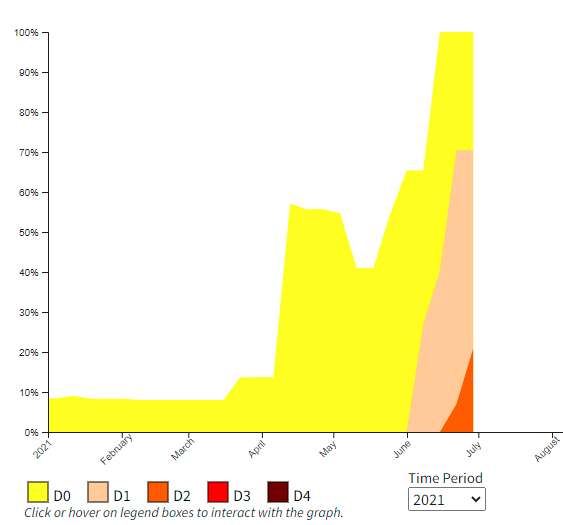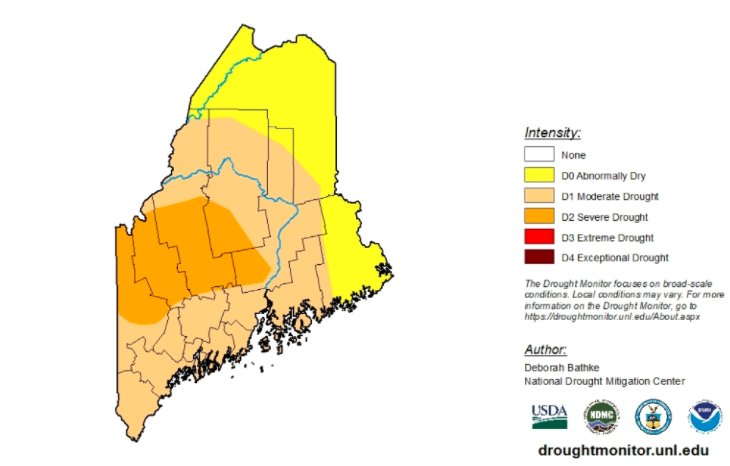
Maine, federal officials keeping an eye on worsening drought
 Courtesy / U.S. Drought Monitor
A map of Maine shows abnormally dry to severe drought conditions across the state, something the state's Drought Task Force is monitoring.
Courtesy / U.S. Drought Monitor
A map of Maine shows abnormally dry to severe drought conditions across the state, something the state's Drought Task Force is monitoring.
The prolonged drought in Maine, which is affecting farmers, public water systems and private wells, is worse than what the state experienced in 2020, and will likely continue, the Maine Drought Task Force reported Thursday.
"We're already starting to see conditions month to month that are well below normal," said Nick Stasulis, data section chief of the U.S. Geological Survey and co-chair of the task force. "We didn't get the significant spring recharge we were hoping to see."
Central and western Maine are experiencing the most severe drought conditions in the state, with most streamflow stations — the spots where water levels are measured — reporting the lowest levels they've had in 30 years, the task force reported. Maine had a rainfall deficit in May and June, with Caribou and Portland logging their warmest Junes on record.
The task force convened Wednesday to discuss drought conditions across the state, and reported Thursday that it will meet again in a month, unless the situation gets worse, in which case it will meet sooner.
The group is made up of state, federal and private scientific, agricultural, regulatory, water use and natural resources organizations. The task force meets when abnormally dry conditions in the state become elevated, helps monitor them, and recommends action to minimize impact on public health, safety, the environment and agriculture.
Maine has been in a drought since mid-May 2020, and, as of early June, abnormally dry conditions affected 100% of the state, according to the U.S. Drought Monitor. More than half of Maine was rated moderately dry in April, with the level rising, and as of Wednesday, more than 70% is in moderate drought and 20% is in severe drought.
The Maine Department of Agriculture, Conservation & Forestry noted that farmers who have irrigation are using it heavily in most areas of the state. "The first-cut hay crop has been good, but subsequent hay growth has been slow," said Tom Gordon, public service coordinator.
If the drought is severe enough to affect crop production later in the season, the U.S. Department of Agriculture issues a disaster declaration, which allows the Small Business Administration to make the Economic Injury Disaster Loan program available to farmers.
Task force members say conditions already appear worse than last fall, when the USDA declared drought disasters in Androscoggin, Aroostook, Franklin, Hancock, Kennebec, Knox, Oxford, Penobscot, Sagadahoc, Somerset and Washington counties.

Drinking water, wells affected by drought
Susan Breau, with the state's Drinking Water Program, said the program has received requests for assistance, mostly from the southern and coastal portions of the state, over the last few weeks. The program is part of the Maine Center for Disease Control and Prevention, and helps public support and monitor public water systems.
Public water systems are taking measures to accommodate low water levels, she said.
There have also been some instances of dry wells in the state, according to the Dry Well Survey for private landowners and private wells.
Aside from affecting crops and drinking water, drought adds a risk of wildfires and also creates more dust in the air that can affect people with respiratory issues and increase the risk of respiratory infections, the U.S. CDC said.
In April, the Maine Emergency Management Agency and the U.S. Geological Survey held a preliminary meeting to prepare for what they predicted would be extensive abnormally dry conditions in Maine that would trigger the task force meeting.
Maine Emergency Management Agency Director Peter Rogers said that the task force will work in together during the summer to keep an eye on the multiple threats of hot, dry weather. "I'm concerned about lightning strikes and dry well reports," Rogers said. "It's really critical to keep information flowing."
While the coming days offer some relief with cool weather and rain, it's a temporary situation, not a drought fix, the task force report said.
"The heat will break down as we enter the holiday weekend. We can expect a good cool down with gradually decreasing humidity," said Sarah Jamison, of the National Weather Service, in Gray. "But the outlook for next week will heat up again."
The task force is made up of the USGS New England Water Science Center, Maine Office; MEMA; National Weather Service Gray and Caribou offices; Maine Geological Survey; Department of Agriculture, Conservation and Forestry; Department of Health and Human Services; Maine Public Utilities Commission; Maine Rural Water Association; Maine Water Utilities Association; Maine Department of Environmental Protection; U.S. Department of Agriculture; county Emergency Management Agencies impacted by drought. The USGS and MEMA are co-chairs of the committee.










0 Comments